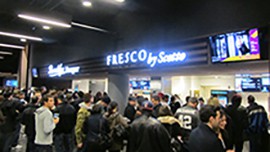By NICK KRUEGER
Cronkite News
A $20 cup of soup, a $16 cheesesteak, $11 for hot chocolate. Those were just some of the high-priced menu items at last year’s Super Bowl XLIII at Met Life Stadium in East Rutherford, N.J.
The days of a simple hot dog, popcorn and a small soda at the game are long gone. This is the new normal for concessions at the Super Bowl, where vending companies have raised prices and expanded offerings to more premium options.
“The planning really starts a year in advance,” said John Muscalo, the Vice President of facilities for Legends Facilities, which was in charge of concessions for Super Bowl XLV in Dallas and Super Bowl XLVIII at MetLife Stadium last season. “With the Super Bowl, to some degree, we started two years out.”
Muscalo and his staff are responsible for bringing the now famous “Cowboyrita” to AT&T Stadium which hosted its first Super Bowl in 2010. It includes 100 percent Hornitos blue agave tequila and is served in a special souvenir cup. Legends also served up a one-pound cheeseburger at the big game between the Packers and Steelers.
“You’re seeing in California and Seattle for instance a lot of different sushi and salad, fancier foods that obviously cost more to develop, but obviously the return on investment is much greater,” said Dan Borschke, the Executive Vice President of the National Association of Concessionaires. “It’s more restaurant oriented than it is concession oriented when you think about it. We might as well get them eating the $15 beef sandwich rather than the $5 hot dog.”
The real money being made in the concession industry is in the suites where vendors, which often pull double duty as catering companies, can serve more high-end food and spirits. Every last popcorn kernel ends up counting, as vendors need each person to spend $10 to $15 on food at the game in order to turn a profit according to Borschke.
“My profit is positively affected when the Super Bowl comes to town because we sell so much more product,” said Gary Wattie, the Senior Vice President of sales for Centerplate, which was in charge of concessions during Super Bowl XLII at University of Phoenix Stadium. “My per caps increase dramatically. It could be as much as twice what it would normally be for a typical NFL experience.”
The food costs are also brought up because of demand and an audience which vendors know paid a pretty penny to get in the door and can probably afford the higher prices regardless. At Super Bowl XLVII in New Orleans, fans paid $14 for nachos, $9 for a hot dog and $12 for a 20 ounce draft beer.
“It’s more restaurant oriented than it is concession oriented when you think about it. We might as well get them eating the $15 beef sandwich rather than the $5 hot dog.” — Dan Borschke, the Executive Vice President of the National Association of Concessionaires.
It is not only the food that is utilized to take advantage of such an important game, configuration of the stadium can also be manipulated so more money can be made by the concessions vendor.
“Quite often suites will be reconfigured,” Wattie said. “What was once two to three to four suites depending on the size of the stadium become one very large suite.”
Extra tents and kiosks are also brought in so there are more points of sale throughout the stadium. This can reduce wait times and keep attendees coming back for more food, which translates into more money.
The company in charge of concessions often takes home 70 to 75 percent of concession profit during a given game. During the regular season, the other 20 to 25 percent of profits are given to the facility or NFL team depending on who owns the property. At the Super Bowl, however, that smaller percentage is given to the NFL according to Wattie.
Although it may seem like a lot of money for the vendor, the company still has to pay its employees, which are usually contracted or brought in on a game-by-game basis.
Legends brought in over 600 extra employees for its Super Bowls in Dallas and New York.
This presents its own challenges.
“Your staff is going to have to start reporting as early as 4 a.m. in the morning and uniforms also have to be organized if you’re going to do a special uniform for the event,” Muscalo said. “You also have to establish how you’re going to get your help in the building and what requirements they have to go through because you’re not going to have parking anywhere close by. For the Super Bowl, parking is going to be a fairly long distance away so all the staff is going to be bussed in.”
Rojo Hospitality Group runs the concessions at University of Phoenix Stadium in Glendale. It took over for Centerplate in 2009 when the Cardinals decided to go in-house with their own concessions instead of contracting out the service to a third party such as Legends or another well know company such as Levy Restaurant Group or Aramark.
They’re one of the few teams in the NFL who operate their concessions in this manner and will certainly have their hands full come gameday. But once the game is over, their pockets are sure to be full too.
“You only have so many stomachs to fill and you might as well fill it with more expensive product,” Borchke said. “This industry is not philanthropic. We’ll only sell what sells and we’ll sell you anything if you buy it.”
“You only have so many stomachs to fill and you might as well fill it with more expensive product. This industry is not philanthropic. We’ll only sell what sells and we’ll sell you anything if you buy it.” — Dan Borschke, the Executive Vice President of the National Association of Concessionaires.

Fans line up for concessions at the Barclays Center.
Wikimedia